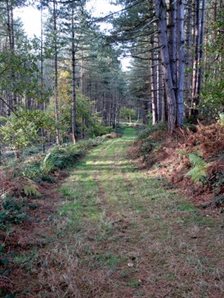Tingrith Before 1086
The Bedfordshire Historic Environment Record [HER] contains information on the county’s historic buildings and landscapes and summaries of each entry can now be found online as part of the Heritage Gateway website. This part of the county is singularly deficient in prehistoric sites and finds, none, for example, being recorded for the neighbouring parish of Eversholt or the nearby parish of Aspley Guise and a single axe-head being recorded for Husborne Crawley. Cropmarks are made by ancient walls, ditches and banks affecting the way crops grow so that the disparities may be seen from the air. Tingrith has two cropmarks which may (or may not) be prehistoric, finds from excavation or fieldwalking would be necessary to confirm the possibility. A linear cropmark has been identified north of The Castle [HER 15177] and circular and linear features have also been identified [HER 14747].

A reconstruction of an Iron Age round house at Flag Fen October 2011
Otherwise the earliest known occupation in the parish dates from the late Iron Age. Two coins of the great King of the Catuvellauni, Cunobelin and dating to between 10 and 43 AD were found by metal detecting [HER 18454 and 18545] .
Eversholt has no Roman remains other than a possible Roman road which runs through the parish. Tingrith, however, has had a number of finds of Roman coins. A coin hoard of over two thousand coins was found during sand quarrying in 1961 [HER 236]. They had been placed, as is often the case with hoards, in a pottery vessel and then buried in a pit. A lozenge-shaped marker stone seems to have been placed on top but clearly the owner never got the opportunity to retrieve his cache. A nearby hearth and cooking vessel may wel have been contemporaneous with the hoard. Most of the coins seem to have been in mint condition or nearly so. Most were struck in the later years of the Emperor Constantine (307-337) by the mints of London and Trier in Germany. The time span dates from around 296 to 300 to 350.
Other Roman coins found in Tingrith are as follows:
- A worn copper as (early Roman equivalent of the 19th century penny) from the 1st century was found south-west of Manor Farm [HER 18555];
- Two worn copper ases of 1st or 2nd century date was found north-east of Daintry Wood [HER 18550 and 18553];
- A silver denarius of Hadrian (117-138) minted between 134 and 138 found south of Manor Farm [HER 18564];
- A brass sestertius of Faustina I, wife of Antoninus Pius (138-161) was found south-west of Manor Farm [HER 18559];
- A brass sestertius of Commodus (180-192) was found north-east of Daintry Wood [HER 18554];
- A worn radiate coin dating to roughly 260 to 275 was found east of Castle Farm [HER 18571];
- A worn radiate of the mid-3rd century was found south-west of Manor Farm [HER 18552];
- A radiate coin of the British usurper Allectus (293-296) was found east of Daintry Wood [HER 18464];
- A small copper coin of Constantine minted between 307 and 318 was found east of Daintry Wood [HER 18456]

Daintry Wood
A small bronze figurine of an elephant was found by labourers digging a ditch in 1836 at Brick Kiln Ground [HER 1412]. A copper ally T-shaped brooch discovered by metal detecting west of Wood End Farm [HER 18467] dates from the 1st or 2nd century. A copper alloy bracelet in the shape of a snake was found by metal detecting north-east of Daintry Wood [HER 18562]. A copper brooch of the 1st century AD of a variety known as Colchester two-piece type was found in the parish [HER 19721].
A heavily corroded copper alloy amulet found south-west of Manor Farm [HER 18563] may be late Roman or early Anglo-Saxon. An Anglo-Saxon brooch found south of Manor Farm [HER 18565] , also heavily corroded dates from the 5th to 7th centuries. Another Anglo-Saxon brooch was found west of Harlington Wood End by metal detecting [HER 18455]. It, too, is copper alloy and probably dates from the late 5th or early 6th century. An incomplete disc brooch from the 5th or 6th century was found south-west of Manor Farm [HER 18547].
The one occupation site recorded from Tingrith lies north-west of Wood End Farm [HER 15836] and seems to have begun in the middle Iron Age and run right through the Romano-British period Animal remains and pottery have been found.